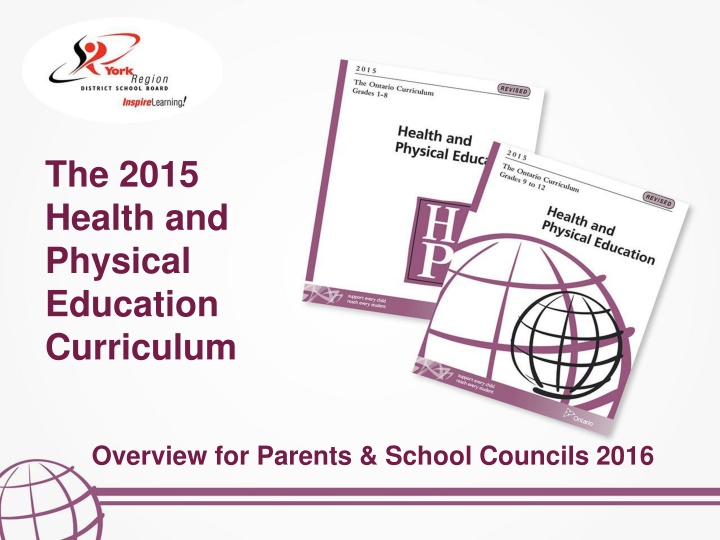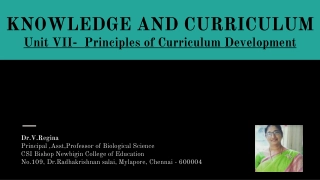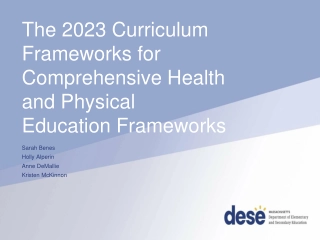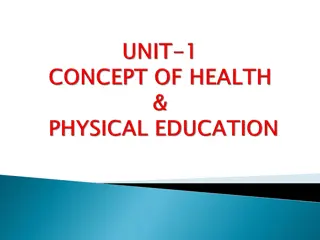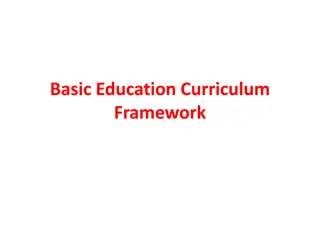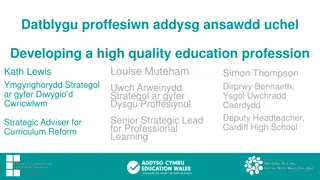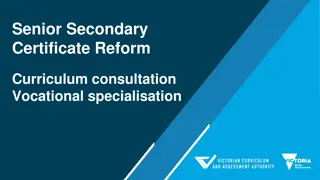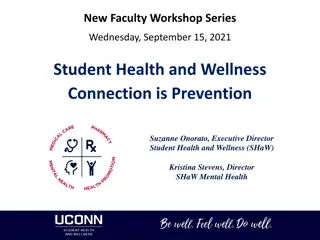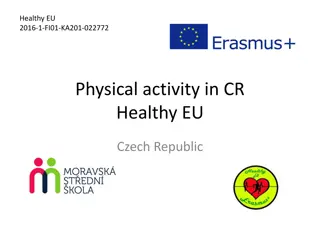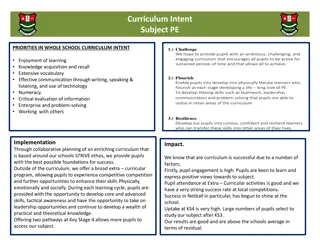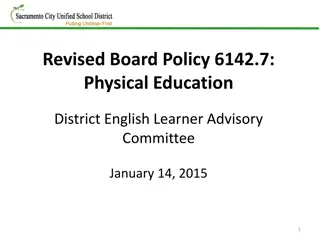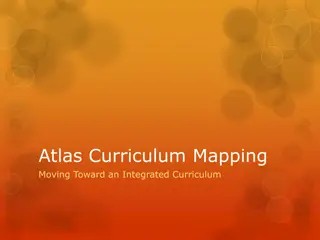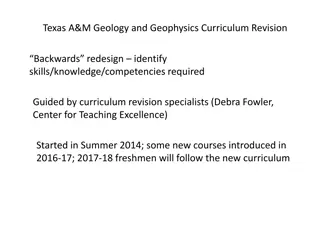Enhancing Health and Physical Education Curriculum for Student Well-being
This comprehensive overview covers the 2015 Health and Physical Education Curriculum, focusing on key changes, updated structure, and resources for educators to support Human Development and Sexual Health topics. The curriculum emphasizes building important skills like communication, emotional awareness, and healthy relationships, with a strong emphasis on consent and safe technology use. Collaboration between schools, parents, and communities is highlighted for effective student support and learning.
Download Presentation

Please find below an Image/Link to download the presentation.
The content on the website is provided AS IS for your information and personal use only. It may not be sold, licensed, or shared on other websites without obtaining consent from the author.If you encounter any issues during the download, it is possible that the publisher has removed the file from their server.
You are allowed to download the files provided on this website for personal or commercial use, subject to the condition that they are used lawfully. All files are the property of their respective owners.
The content on the website is provided AS IS for your information and personal use only. It may not be sold, licensed, or shared on other websites without obtaining consent from the author.
E N D
Presentation Transcript
The 2015 Health and Physical Education Curriculum Overview for Parents & School Councils 2016
Overview of the Session Provide an overview of the updated curriculum, key changes, and structure Explore resources/ materials that educators will be using to support their planning and implementation of the Human Development and Sexual Health topics Address questions that were submitted prior to this presentation If there are more questions afterwards, please contact your principals
Overview of the Curriculum https://www.principals.ca/stream/video/videoLibrary /HPE.mp4
Three Cheers What important skills and knowledge will our students learn and develop through this curriculum?
Working Together To Keep Our Students Safe and Healthy Education is most effective when schools, parents and communities all work together to support students learning Parents are the primary educators of their children with respect to learning about values, appropriate behaviour, and ethno- cultural, spiritual, and personal beliefs and traditions and they are their children s first role models (page 13).
Example of Key Changes Learning about Healthy Relationships, including Consent throughout the curriculum Primary Junior Intermediate identify and name feelings and emotions communication skills to stand up for themselves listen to and respect others develop the skills for healthy relationships both in person and online learning about threatening situations the benefits and potential risks associated with use of technology develop communication, assertiveness and refusal skills
Realities and Misconceptions Students will learn about body parts and be able to identify them correctly in grade 1. Students will not be learning about having sex in grade 1.
Grades 1-3: Human Development and Sexual Health Students are learning about: The names of body parts An initial understanding of how bodies work Skills for healthy, respectful relationships with peers and families Their senses, hygiene, oral health and stages of development Physical health as one part of overall health and well-being Feelings and emotional awareness and to get help if needed Social and emotional health (e.g., getting along with others, recognizing their feelings, learning coping skills, etc.)
Sample Activities for Grade 1 Learning Goal: Students will identify body parts, including genitalia, using correct terminology. Sample Activities: 1. Using Ophea s Body Part Cards (e.g., foot, hand) , students play a Guess the Body part game, then place parts on a life-size outline of a body. 2. Discuss missing parts. Teacher asks: Why do we call some parts of our body private? Why is it important to know your own body and use the correct names for the parts of your body?
Realities and Misconceptions Students are taught to recognize that they themselves, or others, may identify differently. The curriculum supports sharing with our students that we learn in an inclusive community where all differences are supported, valued, and respected. Students are not taught to question if they are a boy or girl and are not pushed to question their own gender identity.
Grades 4-6: Human Development and Sexual Health Students are learning: About the physical changes that occur during puberty About the emotional and interpersonal changes and stresses that come with puberty To understand reproductive and bodily processes More about healthy relationships
Sample Activities for Grade 4 Learning Goal: Students will apply personal skills as they describe the physical changes that occur at puberty and the emotional and social impacts that may result from these changes Sample Activities: 1. Students brainstorm ground rules for a safe and inclusive classroom. 2. Think, Pair, Share What are some of the feelings a Gr4 student might have as they start to experience changes with puberty? (e.g., Embarrassed, confused, excited self-conscious, relief). Pairs write their responses on an index card. Share the responses out loud with the class.
Realities and Misconceptions In grade 7, students are expected to identify ways of preventing Sexually Transmitted Infections and unwanted pregnancies. The curriculum addresses delaying sexual intercourse and the risks associated with any sexual behaviour. It does not teach students how to engage in oral and anal sex.
Grades 7-12: Human Development and Sexual Health Students are learning about: Identity, personal safety, decision making and relationships with peers, family, and romantic partners Delaying sexual activity Preventing sexually transmitted infections and pregnancy Factors that influence decisions (e.g., peers, media and information) Resources related to sexual health such as public health services, community health agencies, reliable and accurate websites
Sample Activities for Grade 8 Learning Goal: Students will demonstrate an understanding of aspects of sexual health and safety, including the concept of consent Sample Activities: 1. Teacher asks: When considering the level of intimacy that is appropriate in a relationship, what does a person need to think about? 2. Working individually, students read Student Resource: How to Be Your Own Person . 3. Working in small groups, students create a response to the following scenario: The person you have been dating wants to visit you while you are babysitting.
Ministry Materials for Parents Curriculum Guides and Overviews for Parents: Grade-by-Grade Curriculum Overviews Guide to Revised HPE Curriculum, Grades 1-12 Guides to Human Development and Sexual Health in the HPE Curriculum for Grades 1-6 and for Grades 7-12 Overview of Sexual Health Component (Ontario.ca\HPE) Quick Facts for Parents Learning About: Healthy Relationships and Consent Online Safety, including Risks of Sexting Mental Health Concussions Staying Safe Active Transportation
YRDSB Resources For Parents and Educators YRDSB Parent Guide Contents- Introduction, Key Messages, Grade by Grade Outlines for Human Development and Sexual Health, Q and A s for Parents Parent Letters for Health The Framework for responding to Faith Requests for Curriculum Accommodations
Process for Responding to Faith Requests for Curriculum Accommodations
From Page 3 of the YRDSB Parent Guide The revised HPE curriculum builds a climate of inclusion. The revised curriculum values all students. Religious, or any other accommodation, for lessons that build a climate of inclusion and safety, including discussions kinds of families or any of the other human rights protected under the Ontario Human Rights Code cannot be provided. about different
Three possible Outcomes 1. Curriculum accommodation for faith purposes 2. Curriculum accommodation of exemption for faith purposes 3. Parental withdrawal
When parents are engaged and involved, everyone benefits and our schools become increasingly rich and positive places to teach, learn and grow. Supporting the Ontario Leadership Strategy, 2012, p.1
